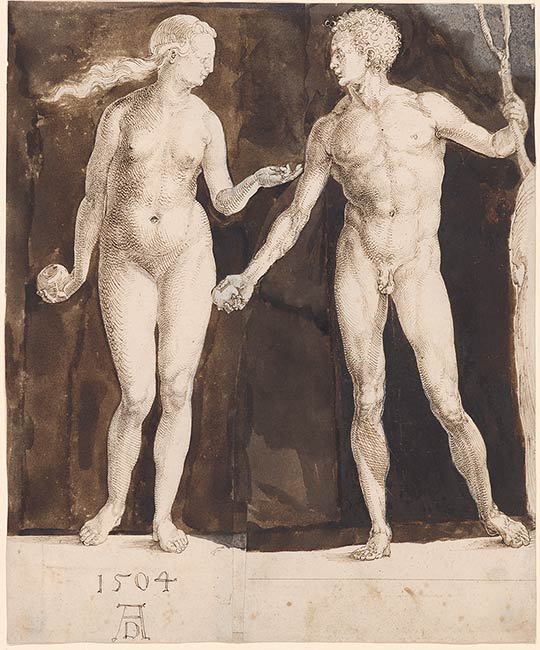
Dürer was the first northern renaissance artist to attempt to master the classical depiction of the human figure according to rational notions of proportion and measurement. His efforts culminated in the celebrated 1504 engraving Adam and Eve (see 2006.80 for the Morgan's exceptional impression), a subject that afforded him the opportunity to juxtapose the ideal male and female nude. The five states of the print, an unusually high number for Dürer, together with the large number of preparatory drawings, document the particular care with which he planned the design. The artist's evident pride in the print is displayed in the longest, most prominent inscription he ever included on an engraving: Albrecht Dürer of Nuremberg made this 1504.
The present drawing is arguably the most significant of the known preparatory studies for the engraving and is the only one that depicts Adam and Eve together. It is, in fact, made up of two sheets of paper; Dürer united two separate drawings, each bearing a nude figure, onto one large sheet. He carefully trimmed the figures' outlines before uniting them, adding a strip of paper in the middle and applying dark brown wash to the background to unify the composition. The figures in the present drawing and the final print are predominantly in agreement but in light of small yet significant changes-the engraved Adam, now taller than Eve, no longer holds an apple, while Eve willingly takes a second one from the serpent-it is likely that a further drawing served as the final model for the engraving and was used to transfer the design onto the plate. Earlier stages in the conception of the figures are documented in proportion and figure studies in the Ashmolean Museum, Oxford; the British Museum, London; and the Albertina, Vienna. The sheet in the British Museum shows the artist experimenting with and without the apple. The figure of Adam in the present drawing and the print is reminiscent of the Hellenistic sculpture, the Apollo Belvedere (Vatican Museum, Rome), excavated in Italy during the late fifteenth century. In 1507 Dürer would explore the Adam and Eve theme on a monumental scale, as seen in the pair of painted panels now in the Prado, Madrid (P002177 and P002178).
The ideal proportions of the human figure preoccupied Dürer throughout his career, beginning with a series of constructed nudes from around 1500, when he met Jacopo de' Barbari (ca. 1460/70-ca. 1516), the Venetian artist appointed by the emperor Maximilian as court portraitist and miniaturist in Nuremberg. The meeting, during which the master instructed Dürer in his idiosyncratic approach to human proportion, greatly influenced Dürer's own, which he ultimately codified in his Underweysung der Messung (Instructions on Measurement with Compass and Ruler), published in 1525, as well as his Vier Bücher von menschlichen Proportion (Four Books on Human Proportion), published posthumously by his wife Agnes in 1528.
Signed with the artist's monogram and dated at lower left, "1504". Inscribed in pencil on verso at lower right, "Amt. Gsell / No. 586"; numbered at lower left and lower right, "119".
Dürer, Agnes, former owner.
Dürer, Endres, former owner.
Pirckheimer, Willibald, 1470-1530, former owner.
Imhoff, Willibald, 1519-ca. 1579, former owner.
Rudolf II, Holy Roman Emperor, 1552-1612, former owner.
Andréossy, Antoine-François, comte, 1761-1828, former owner.
Gsell, Friedrich Jakob, former owner.
Lanna, Adalbert Franz Josef, Freiherr von, 1836-1909, former owner.
Morgan, J. Pierpont (John Pierpont), 1837-1913, former owner.
Denison, Cara D., and Helen B. Mules, with the assistance of Jane V. Shoaf. European Drawings, 1375-1825. New York : Pierpont Morgan Library, 1981, no. 32, repr.
From Leonardo to Pollock: Master drawings from the Morgan Library. New York: Morgan Library, 2006, cat. no. 51, p. 110-111.

